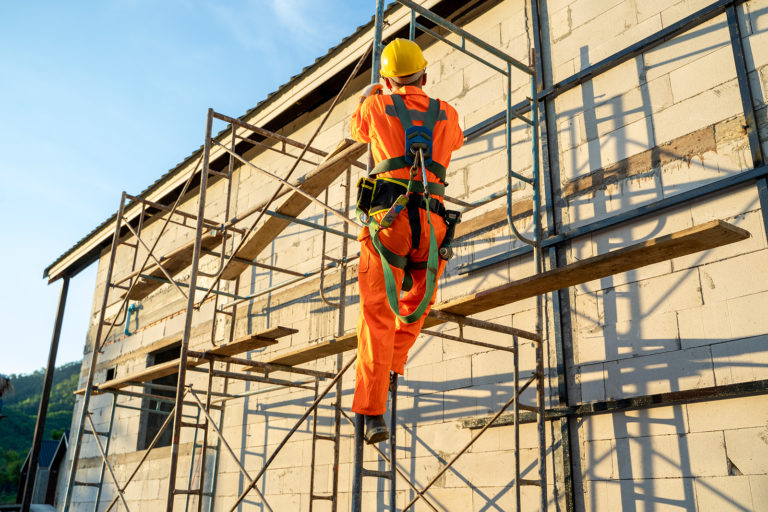What are the OSHA Scaffolding Safety Requirements for Construction Worker Safety?

Construction workers frequently perform tasks at heights which expose them to multiple dangers. OSHA has created specific scaffolding requirements which aim to protect worker safety.
The rules aim to prevent workers from falling and protect them against injuries and dangerous situations when they work on scaffolds.
The third most frequently cited OSHA violation concerns improper scaffolding practices. This article examines OSHA’s scaffolding regulations for construction sites and demonstrates how they protect workers from harm.
The most important scaffolding safety rules along with additional helpful information are presented below.
Critical OSHA Scaffolding Standards & Safety Requirements
Approximately 4,500 workers get injured from scaffolding incidents annually. The annual fatality count for workers who fall victim to scaffolding injuries stands at about 50. The OSHA scaffolding requirements outline has been provided for your convenience below. You should always consult the official OSHA documentation to find additional details and information.
Weight Capacity
What is the maximum load a scaffold should be able to support?
The scaffold needs to maintain structural integrity while being able to sustain its own weight together with four times the heaviest load it will carry. Your scaffold system needs to maintain stability and support weight without any movement or settling. The base for supported scaffolds needs to rest on a completely stable foundation. By implementing these fall protection safety guidelines your workforce will stay protected while your business maintains compliance.
Stability
Planks or scaffold platforms must never rely on unstable objects such as loose bricks, boxes, barrels or makeshift supports for support. The working platform becomes unstable because of such dangerous shifts which lead to higher chances of worker falls. Workers should use scaffold components that meet OSHA requirements specifically built for load-bearing purposes.
Supervised Setup
Workers require supervision from a qualified person during scaffold erection, dismantling, moving, and alteration processes. Supervision ensures scaffold assembly meets OSHA standards and all necessary safety measures like scaffold fall protection and personal fall arrest systems are established before work starts.
Extra Precaution
Scaffold structures need to have toeboards along with midrails and guardrails installed. Wondering about scaffold guardrail height requirements? Here are the scaffold guardrail requirements.
All toprails made and used after January 1, 2000 must have a height ranging from 38 to 45 inches. Toprails that were manufactured and put into service prior to January 1, 2000 need to have a height between 36 and 45 inches.
Maintenance
Brackets, braces, screw legs, trusses, and ladders require routine examinations. People must repair or substitute equipment which shows any signs of weakness or damage without delay. Worker safety depends on the structural integrity of scaffold components which prevents dangerous failures that can cause injuries or deaths.
Materials
Set up your scaffold platforms with tight plank formation and ensure you use the proper scaffold plank grade material or an approved alternative. Improperly fitted planks on a platform can cause workers to trip or allow materials to fall onto workers below.
Scaffolding Inspection
Only certified “competent persons” who have been specifically designated for this role can perform inspections on all scaffolding systems. The certified individual responsible for scaffolding must carry out re-inspections according to established time intervals. Workers face potential hazards from any minor changes or movements.
Rigging Inspection
A qualified professional needs to examine the rigging of suspended scaffolds before every shift begins. Any damage or looseness in the rigging components may result in the scaffold losing stability.
Scaffold connections need to be secure and each component should show no signs of damage. Adjustable suspension scaffolds require inspection to verify that weight distribution remains correct and attachment points stay secure.
Rigging Protection
Monitoring both natural and synthetic rope during suspension scaffold setup is essential. The rigging must be shielded from heat-generating equipment and other heat sources nearby.
Diagonal Braces Instruction
Employees need training to understand the dangers associated with using diagonal braces for fall protection. The OSHA standards mandate workers to use appropriate fall arrest systems including personal fall arrest systems in order to prevent falls. The use of diagonal braces cannot replace scaffold fall protection systems for workers.
Access
Safe access to scaffolding is required. The working platform can only be accessed through designated stairwells or ladders. Workers must never attempt to gain access by climbing on cross braces or using unstable objects because these actions increase fall risks.
Power Line Distance
Maintain a minimum distance of 10 feet between your scaffolding structure and any electrical power lines. Electrocution becomes a fatal danger when scaffolding collapses and contacts live powerlines or electrical wires. Scaffold system installation requires a preliminary assessment of electrical hazards at the job site.
OSHA Scaffold Training
Feeling overwhelmed? Safety Counselling as a safety consulting firm has the ability to help you save both time and energy. Through our training program you and your employees will learn scaffold safety along with additional essential knowledge.
Please note that Safety Counselling is not affiliated with OSHA.
